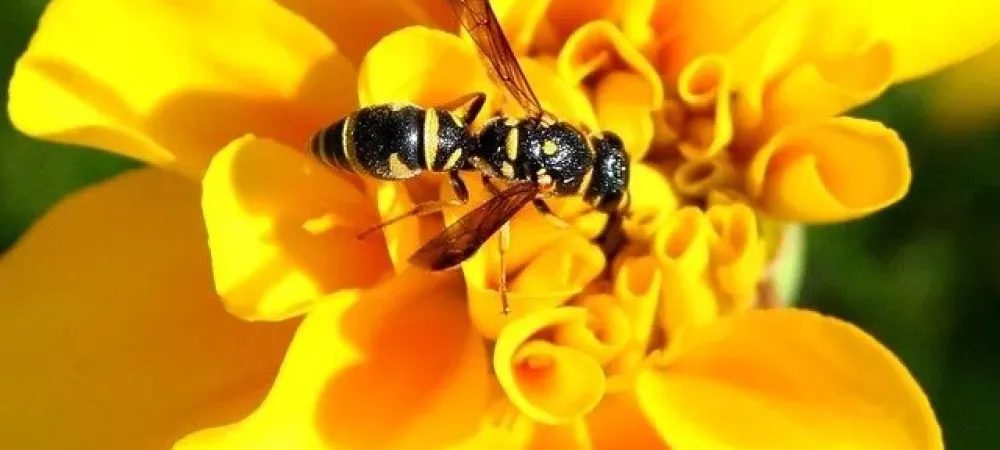Types of Wasps in Pennsylvania

Warm weather brings out many insects in Pennsylvania, especially stinging insects like the wasp. As social organisms, they nest in groups and collectively occupy their nests and care for the young. There are several species of wasps found in Pennsylvania that you may need to know about. The most common types of wasps found throughout the area include paper wasps, the eastern yellowjacket, mud daubers, the bald-faced hornet, and cicada killer wasps.
Are Wasps Dangerous?
Almost all fatal bug bites in the United States are inflicted by wasps and bees, with 40 to 100 people dying annually from stings. Many people do not know they are allergic to the venom, and this is where the issues arise. Wasps can be very dangerous and behave aggressively, especially when defending their nest. Female wasps can deliver multiple repeated stings when threatened. A wasp sting is known to be more painful than the sting of any yellowjacket, hornet, or bee. Although they are dangerous, they are beneficial to farmers as they hunt and consume herbivorous pests such as caterpillars, flies, and aphids. So when does a wasp normally attack? Generally when they feel they or their nest is threatened.
Wasp Identification in Pennsylvania
Wasps are fairly easy to identify if you know what you are looking for in terms of markings, behavior, and size.
Paper Wasps
- Appearance - Paper wasps are the most common wasps in Pennsylvania and can easily be mistaken for a yellow jacket. They are relatively smaller in size and are more narrow in the middle with rear legs that extend behind it when it flies. Paper wasps are brown or bright red in color.
- Diet - These wasps primarily consume beetles, bees, and flies to feed their larvae back in the hive. For their own food source, they consume nectar.
- Habitat - Paper wasps prefer to make their nests on eaves and overhangs.
- Dangers - These wasps are not outwardly dangerous, however, they do pose a risk as they can deliver a painful sting multiple times to anything posing as a threat.
Eastern Yellowjacket
- Appearance - Males have a black and yellow banded appearance and queens are mainly yellow in appearance with small black spots lining the sides of the abdomen.
- Diet - These wasps can be scavengers of decomposing organic material or consume insects found on vegetation such as aphids, caterpillars, and flies. The Eastern Yellowjacket is one of nature’s natural custodians as they consume insects that can damage crops and make the environment cleaner.
- Habitat - Yellowjackets typically make their nests underground or at the base of building walls or pavement openings. Several species of yellowjackets can be found in Pennsylvania.
- Dangers - The Eastern Yellowjacket is dangerous and should be avoided. These wasps will sting when sensing a threat to the nest of their young.
Mud Daubers
- Appearance - Mud Daubers are long slender about 1 in (25mm) in length. They have a “thread-waisted” body shape with a long thin section stretched between their torso and thorax. Unlike other wasps, the mud dauber is unique in color and can be completely black or metallic blue. Some species have yellow or green markings on their body as well.
- Diet - These wasps are known for eating spiders as their preferred source of food. They will also eat nectar and sweet fruit such as honeydew.
- Habitat - The nest of the mud dauber often looks like a mud-covered cone in appearance. The name is given to these wasps for the mud the female uses to make their nest using their mandibles. The mud dauber nest is commonly found on horizontal or vertical faces of walls, bridges, overhangs, and other elevated structures. Multiple nests can often be found in one place close together.
- Dangers - Mud daubers are not considered dangerous. They are found in much smaller groups and only carry small amounts of venom which lack antigenic properties.
Bald Faced Hornet
- Appearance - Bald Faced Hornets resemble yellow jackets although they have a distinctive white face giving them their name.
- Diet - As aggressive hunters, this wasp hunts live insect prey and can feed on insects most humans consider pests such as yellow jackets and flies. These wasps sting their victim repeatedly and spray venom to trap their prey.
- Habitat - The Bald Faced Hornet makes a large paper nest above ground often hanging from a tree or attached to the side of a building.
- Dangers - These helpful pest-consuming insects should only be observed from a quiet distance as they are dangerous. They will sting anyone who comes near their nest. If removal is necessary, relocation is recommended rather than eradication.
Cicada Killer Wasps
- Appearance - Cicada Killer Wasps are large wasps about one and a half to two inches in length and black or dark brown with colorful yellow markings on segments of their abdomen.
- Diet - The larvae feed on cicadas that the adult will sting to paralyze and return the living insect to its nest for the larvae to consume. Adult wasps of this species will consume nectar and fermented sap.
- Habitat - Cicada Killer Wasps prefer areas in full sun where cicadas are plentiful. They are ground nesters preferring sandy or loose soil to build their nests.
- Dangers - These wasps are not likely to sting, however, removal is recommended.
How to Get Rid of Wasps
If you find you have wasps in your yard, you can try to get rid of wasps yourself by:
- Hanging wasp traps which attract, trap, and kill wasps. These must be changed regularly.
- Spraying wasp nests with insecticide, but be sure to wear protective clothing and follow product instructions.
- Put a soap and water mixture spray onto the nest to clog nest pores.
- The most effective solution? Hiring a professional pest control service with experience removing wasp nests safely.
Do Wasps Pollinate?
Wasps are not considered pollinators. Most species do not have the anatomy to pollinate as they do not have the fur-like soft fuzzy hairs on their body that collects pollen as bees do. As a result, wasps are not effective pollinators as they lack the ability to transport pollen. There are a handful of species that can pollinate without these hairs such as the fig wasp, which pollinates fig trees.
Having Trouble Getting Rid of Wasps? Contact D-Bug Today!
Stinging insects can pose a danger to you and your family and prevent you from enjoying your home. The safest route to remove wasps and their nests from your property is to leave it to the experts at D-Bug! We have over 80 years of experience with stinging insect control and know how to safely and effectively remove wasps and treat the area so you have long-lasting relief.


